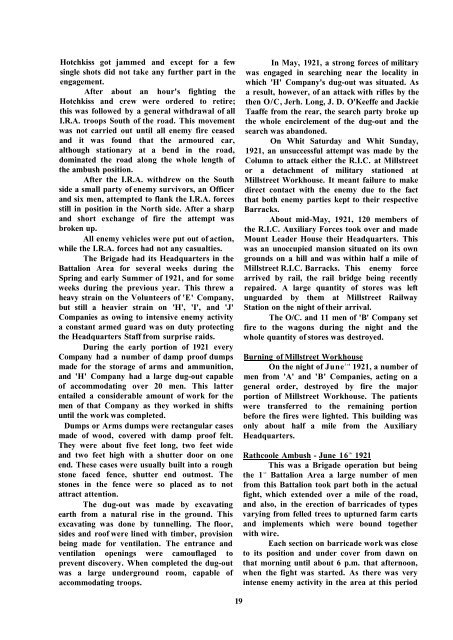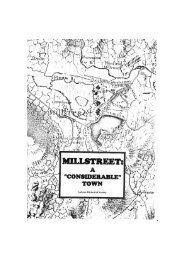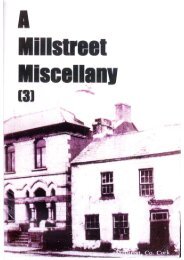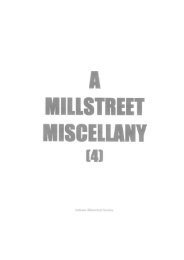The 'Boys' Of The Millstreet Battalion Area - Aubane Historical Society
The 'Boys' Of The Millstreet Battalion Area - Aubane Historical Society
The 'Boys' Of The Millstreet Battalion Area - Aubane Historical Society
Create successful ePaper yourself
Turn your PDF publications into a flip-book with our unique Google optimized e-Paper software.
Hotchkiss got jammed and except for a few<br />
single shots did not take any further part in the<br />
engagement.<br />
After about an hour's fighting the<br />
Hotchkiss and crew were ordered to retire;<br />
this was followed by a general withdrawal of all<br />
I.R.A. troops South of the road. This movement<br />
was not carried out until all enemy fire ceased<br />
and it was found that the armoured car,<br />
although stationary at a bend in the road,<br />
dominated the road along the whole length of<br />
the ambush position.<br />
After the I.R.A. withdrew on the South<br />
side a small party of enemy survivors, an <strong>Of</strong>ficer<br />
and six men, attempted to flank the I.R.A. forces<br />
still in position in the North side. After a sharp<br />
and short exchange of fire the attempt was<br />
broken up.<br />
All enemy vehicles were put out of action,<br />
while the I.R.A. forces had not any casualties.<br />
<strong>The</strong> Brigade had its Headquarters in the<br />
<strong>Battalion</strong> <strong>Area</strong> for several weeks during the<br />
Spring and early Summer of 1921, and for some<br />
weeks during the previous year. This threw a<br />
heavy strain on the Volunteers of 'E' Company,<br />
but still a heavier strain on 'H', 'I', and 'J'<br />
Companies as owing to intensive enemy activity<br />
a constant armed guard was on duty protecting<br />
the Headquarters Staff from surprise raids.<br />
During the early portion of 1921 every<br />
Company had a number of damp proof dumps<br />
made for the storage of arms and ammunition,<br />
and 'H' Company had a large dug-out capable<br />
of accommodating over 20 men. This latter<br />
entailed a considerable amount of work for the<br />
men of that Company as they worked in shifts<br />
until the work was completed.<br />
Dumps or Arms dumps were rectangular cases<br />
made of wood, covered with damp proof felt.<br />
<strong>The</strong>y were about five feet long, two feet wide<br />
and two feet high with a shutter door on one<br />
end. <strong>The</strong>se cases were usually built into a rough<br />
stone faced fence, shutter end outmost. <strong>The</strong><br />
stones in the fence were so placed as to not<br />
attract attention.<br />
<strong>The</strong> dug-out was made by excavating<br />
earth from a natural rise in the ground. This<br />
excavating was done by tunnelling. <strong>The</strong> floor,<br />
sides and roof were lined with timber, provision<br />
being made for ventilation. <strong>The</strong> entrance and<br />
ventilation openings were camouflaged to<br />
prevent discovery. When completed the dug-out<br />
was a large underground room, capable of<br />
accommodating troops.<br />
19<br />
In May, 1921, a strong forces of military<br />
was engaged in searching near the locality in<br />
which 'H' Company's dug-out was situated. As<br />
a result, however, of an attack with rifles by the<br />
then O/C, Jerh. Long, J. D. O'Keeffe and Jackie<br />
Taaffe from the rear, the search party broke up<br />
the whole encirclement of the dug-out and the<br />
search was abandoned.<br />
On Whit Saturday and Whit Sunday,<br />
1921, an unsuccessful attempt was made by the<br />
Column to attack either the R.I.C. at <strong>Millstreet</strong><br />
or a detachment of military stationed at<br />
<strong>Millstreet</strong> Workhouse. It meant failure to make<br />
direct contact with the enemy due to the fact<br />
that both enemy parties kept to their respective<br />
Barracks.<br />
About mid-May, 1921, 120 members of<br />
the R.I.C. Auxiliary Forces took over and made<br />
Mount Leader House their Headquarters. This<br />
was an unoccupied mansion situated on its own<br />
grounds on a hill and was within half a mile of<br />
<strong>Millstreet</strong> R.I.C. Barracks. This enemy force<br />
arrived by rail, the rail bridge being recently<br />
repaired. A large quantity of stores was left<br />
unguarded by them at <strong>Millstreet</strong> Railway<br />
Station on the night of their arrival.<br />
<strong>The</strong> O/C. and 11 men of 'B' Company set<br />
fire to the wagons during the night and the<br />
whole quantity of stores was destroyed.<br />
Burning of <strong>Millstreet</strong> Workhouse<br />
On the night of June 3rd<br />
1921, a number of<br />
men from 'A' and 'B' Companies, acting on a<br />
general order, destroyed by fire the major<br />
portion of <strong>Millstreet</strong> Workhouse. <strong>The</strong> patients<br />
were transferred to the remaining portion<br />
before the fires were lighted. This building was<br />
only about half a mile from the Auxiliary<br />
Headquarters.<br />
Rathcoole Ambush - June 16 th<br />
1921<br />
This was a Brigade operation but being<br />
the 1 st<br />
<strong>Battalion</strong> <strong>Area</strong> a large number of men<br />
from this <strong>Battalion</strong> took part both in the actual<br />
fight, which extended over a mile of the road,<br />
and also, in the erection of barricades of types<br />
varying from felled trees to upturned farm carts<br />
and implements which were bound together<br />
with wire.<br />
Each section on barricade work was close<br />
to its position and under cover from dawn on<br />
that morning until about 6 p.m. that afternoon,<br />
when the fight was started. As there was very<br />
intense enemy activity in the area at this period





